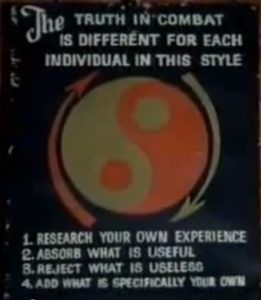Just about every day I get messages on social media and in my inbox about how they can get started in JKD.
Reasons for wanting to study Jeet Kune Do vary. Some do because they’re a huge Bruce Lee fan and watched and re-watched all of Bruce Lee’s movies. While others, like myself, wanted to study the physical art or expression of what Bruce Lee wrote about. Then there are those who watched some of the more recent movies or documentaries about Bruce Lee and are simply curious. There are also those who want to learn how they can put the JKD thought process into what they’re already doing… and the list goes on.
While JKD is popular in some respects, it isn’t very widespread and there aren’t a whole of qualified instructors out there that can teach the physical principles and the structure of Jeet Kune Do. These days though, there are more availability in regards to video lessons and there isn’t a shortage of material on YouTube either…
But with that comes a lot of misrepresentation. (Not saying the material is good or bad, just saying what is often represented as JKD, isn’t.)
 Some feel it is more of a philosophy and it’s about taking the best out of a bunch of different styles; which probably comes from the idea of “self expression” and “adding what is specifically your own”.
Some feel it is more of a philosophy and it’s about taking the best out of a bunch of different styles; which probably comes from the idea of “self expression” and “adding what is specifically your own”.
I trained using that philosophy for years…
The thing is, you don’t know what you don’t know until you know. And if you want to call what you do JKD, then you need to know and understand what JKD should consist of in the first place…
My teacher, Sifu Tim Tackett, once told us:
“JKD has a structure and a way to do certain things. It is more than philosophy about freedom or just a thought. It is not doing your own thing.”
So what is it then?
Here are 10 Things that should be present in your JKD training:
- Balanced, relaxed and functional structure based on Bruce’s unique combination of Fencing / Boxing / Wing Chun.
- Efficient control of distance and time using footwork and tools from boxing / fencing.
- Intercepting
- Centerline awareness and hand immobilization from Wing Chun
- Directness (e.g. closest tool to nearest target)
- Use of broken rhythm
- Economy of Motion
- Primary use of lead hand / lead leg (coordinated side forward)
- Daily decrease (don’t add for the sake of adding something new)
- Power generation from the proper understanding and use of: kinetic chain, gravity, torque, short arc principle etc.
And a whole ton more…
My point being that there’s a difference between being “formless” as opposed to having “no form”. Having “no form”, means that you can do whatever the heck you please. The other means that there is a way, but you are not bound by it. Once you understand, and more importantly can apply, some of the key tenets I listed above, you can then start implementing the idea of: “Adapt what is useful, reject what is useless, and add what is specifically your own”.
The goal isn’t to try to become a clone of Bruce Lee. Your expression will be colored by your physical attributes and prior training background. Hence the aim is to train and create your own individual expression by using his “way” as “your way”.
I know a lot of people completely disagree with me on this, and that’s ok.
But I’ll leave a couple of videos with Sifu Dan Inosanto speaking about the art of JKD, Jun Fan Gung Fu and JKD Concepts:
